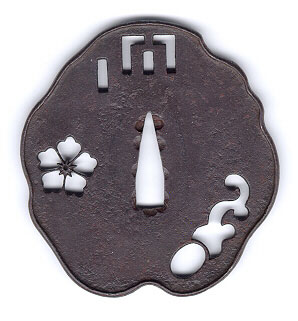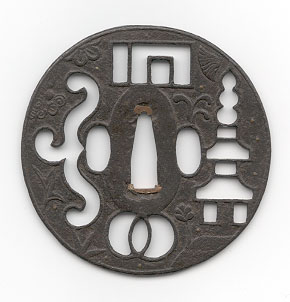Genji-Mon Tsuba
An Introduction
Countless clues and paths to ancient stories, ideals,
mythologies and beliefs lie hidden throughout the endless
This paper will focus on a Japanese Kamakurabori Tsuba decorated with
imagery of a pagoda, overlapping rings, a fluid/cloud like object and a figure
at the top known as a genji-mon. This particular genji-mon
specifically addresses chapter 33 in Lady Murasaki Shikibu’s Tale of Genji. Before I elaborate on the symbolism behind
this I will quickly identify the tsuba and genji-mon.
What’s a Tsuba?
A Tsuba is a mounted
‘guard’ on a Japanese sword. It’s
primary purpose is “to keep the user's hand from sliding up onto the
blade of the sword, to counterbalance the weight of the blade, to communicate
the social standing, beliefs and tastes of its owner, and, to some degree, to
protect the hand from an opponent's blade.
Its role as a hand guard is undermined by its
role as a counter weight, due to the fact that the protection offered by the tsuba from an opponent’s blade is minimal and should not be
depended upon as a typical method of defense.
This particular tsuba is a Kamakurabori
Tsuba from the late Muromachi
period named after the carved lacquer and woodcraft of the city of
connection between the sword’s
owner and his appreciation of The Tale of Genji.


What’s a Genji-Mon?
“Genji
crests ('Genji-mon') are 54 different rectilinear
emblems, each associated with one of the 54 chapters of the 'Genji monogatari' ("Tale of Genji," early eleventh century, written by Murasaki Shikibu)…Genji crests also called 'Genji-kô'
("Genji incense"), were apparently first
derived from one of the traditional incense ceremonies [Kodo]
in which participants burned combinations of 5 primary scents from 25 [later
expanded to 54 to correspond with the Genji chapters]
different packets, each marked with a unique symbol. (Note that each of the 54
'Genji-mon' are composed of 5 primary vertical stems
with different arrangements of one or more upper horizontal cross bars).”
The Significance of the Combination
You maybe asking yourself, “okay there’s the genji-mon that seems to have something to do with incense,
and there’s the tsuba which is part of sword…now
what’s the point?”
In the days of the Samurai
lifestyle and mannerism were dictated my social status. For example, the way a samurai dressed was
very much dictated by tradition…there is not in any research I’ve done any
significant evolution of samurai dress code, no new trendy masks or armor. Long story short, there were no casual
Fridays were a Shogun could wake up and handle his business wearing silk pants
and a t-shirt. The same could be said
about any social class; no matter where you were in societies social hierarchy,
your life was dictated by a strong set of standards ranging from who you can
meet to where you were buried.
Earlier I quoted Dr. Torigoye, stating, “samurai saw the
I
imagine the owner of this tsuba to relate strongly to
the ideals embedded with this genji-mon. To properly understand these ideals, I will
quickly summarize the 33rd chapter of the Genji
tales to which this emblem implies.
Chapter 33 tells the tale of a
sickly Suzaku emperor whose time of death is visible
on the horizons. He has a daughter known
as The Third Princess, who without her father would face financial misery
without a proper husband. This situation
causes the emperor to reach out to Genji. The Emperor knows that Genji
is known to be a womanizer, but overlooks this because Genji
also has the reputation to take care of the women in his life. Now
a samurai who wears a crest referencing this emblem probably feels an
overwhelming connection to the chapters underlying theme of paternal
responsibility. Now lets look past the
term ‘paternal’ and focus on the underlying principles that this envelops. For instance the desire to conduct one’s
mannerism so that an example is set for others to follow is one such
trait. Another trait would be to risk
happiness to ensure the survival of those dependant on you (as seen when the
emperor weighs Genji’s womanizing against his
reputation of being financially responsible).
This trait goes parallel with the need to make life-changing decisions
that can affect others (such as the decision maker’s family, friends, employees
etc).
The
traits mentioned above share a common theme, selflessness. Each and every trait associated with
‘paternal’ responsibility is undermined by the theme of devoting yourself to
the well being of others. This mentality
itself is directly fused with the ideals of the Samurai. The Samurai were known to hold themselves to
the strictest codes of honor and loyalty towards themselves and their immediate
superior, to disregard this code meant disgrace…remedied only through a
suicidal ritual. So in essence the genji-mon on the tsuba reaffirms
the samurai’s belief in his role in society…similar to a father who tattoos his
newborns name on his chest in order to affirm that, “this is my child, and I am
his father.”
Okay,
we’ve looked at the possible link between The Tale of Genji
and our Tsuba in terms of moral implications, but so
far we ignored an equally important aspect of the Genji-Mon,
its connection with traditional incense burning and what that means to our
samurai friend.
The
Art of Kodo (Koh doh) is one that can be immediately enjoyed yet can take
over 30 years to master. The Art consist
of performing the incense ceremony, making incense and learning various incense
games. This is probably a very shallow
explanation of Kodo due to that fact that I am not
too familiar with the practice.
Historically incense burning in
The
spiritual implications added to the tsuba through the
historical context of the Genji-Mon add an even
richer meaning to the overall impact of its presence on the tsuba. Does this mean that the man who owned this
sword was a spiritual man? Not directly,
no, but it would be ignorant to completely discard this aspect of the genji-mon.
Uncovered Aspects of Symbolism
Now I must take this time to
address the various other aspects of the Tsuba, which
are not covered in depth in this paper.
In
my introduction I stated that, “In
this realm of viewing art, the viewers knowledge of Japanese History in all its
genres are crucial to understanding Art the way it was meant to be seen by the
Artist.” My knowledge of Japanese
symbolism is restricted to a semester of Japanese art history and my gathered
knowledge through various other means.
This paper focused primarily on the genji-mon
and Tsuba, but 3 other very distinct symbols appear
on the Tsuba, which are ignored in my analysis for
the sake of focusing the argument to a specific literary source. For example, on the right side of the genji-mon there is a cutout of what is most obviously a
two-story pagoda. Historically the
pagoda’s function is that of a reliquary for the remains of the Buddha. Thus anchoring its roots so obviously in
Buddhism and all its aspects. The two
overlapping rings located opposite the genji-mon are
alien to me in meaning but are reminiscent of overlapping rings that stand
vertical behind Yakushi
in the Yakushi Triad.
Finally the fluid/water like symbol opposite the pagoda is alien to me
as well, but its size indicates importance and I’m sure that its meaning
deserves as much attention as any other on this tsuba.
With that said, I would like to comment on the
protective aspects of the Tsuba itself intermingled
with the ideals associated with the symbolism depicted. I would imagine if I was a samurai and I
commissioned an artisan to make me this tsuba I would
have carefully chosen which symbols I wanted and where I wanted them. Its not the case that the Samurai had these
insignia’s sown into his dress robes, no, he had them embedded into his tsuba, the protector of his hand, the balancer of his
sword, and the key to his success as a warrior.
During numerous battles a sword must endure tremendous torque, tension
and abuse…durability is second to none in sound weapon. You wouldn’t protect your household with a
gun that’s known to misfire, and a samurai cannot be expected to serve his
master with a sword known to faulty. The
sword only comes in second to the samurai’s hand that controls it. The samurai’s skill is concentrated through
his blade, and coincidently the barrier between man and metal is the tsuba.
Now lets say I value my sword
and my hand, therefore my tsuba must be more than a
mere hand guard, it must be every bit as worthy to enter battle as my blade and
my heart, therefore I make sure that my tsuba ‘prays’
for me every time I swing my sword in hopes that its function is never
inhibited. So I adorn my tsuba with insignia of the morality and spiritual beliefs I
hold so dear to my heart. So through
symbolism and function I have created a shield in which my belief in
responsibilities, and the teachings of Buddhism are evident every time I
unsheathe my sword. This idea is the
ultimate reality when the marriage of symbolism and function take place in this
tsuba.
To Conclude
It is clearer now than it was this morning the
implications literature has on objects, whether functional or decorative. This particular tsuba
is infused with tremendous meaning both for me as a scholar, but even more so
to the man who originally owned this. I
feel that my view on the tsuba is severely limited to
my knowledge and study of a single emblem, which is only ¼ the insignia
embedded on the tsuba. In a way it kind of boggles the mind to think
on what my outlook in life would be had I had a richer education in the history
of many things. I doubt that I would
ever be able to glance randomly throughout the city and not see a thousand
tales and legends breathing the air of my vision.
BIBLIOGRAPHY